Where does the counteroffensive lie?
Starting from May 11 on, where we left in the previous article, May 10, a lot of events and processes have taken place since then. Let’s look them firstly day by day and then make some conclusions.
Day by day “event calendar”
May 11
AFU started a kind of counter-offensive / reconnaissance / probe attacks around western and northern flanks of Bakhmut/Artyomovsk and made some territorial success. In the city itself, Russian troops advanced again in the “Citadel area”. The main part of the AFU attack wave was recorded in Donetsk region. In Sumy and Chernihiv regions Russian Air forces (RuAF) were reportedly using massively planning bombs. According to Zelensky, AFU is still waiting for more western arms supply before launching a big attack. His office just asked to supply over 3000 more drones.
May 12
AFU offensive in Bakhmut direction begins looking more like trying to push back Russian troops on the flanks to be able to evacuate Ukrainian soldiers from the last part of Bakhmut city. On May 11 – 12, new Ukrainian advance was reported on the western outskirts of Bakhmut. RuAF made a large number of strikes on Ukrainian targets to diminish AFU’s offensive capabilities. At least 145 air strikes, 6 missile strikes and about 200 MLRS strikes were on Ukrainian targets. During the first 24 hours of AFU offensive campaign, the Ukrainian military attempted over 20 attacks along the 100 km engagement line in Donetsk tactical area, with total losses amounting up to 1200 Ukrainian servicemen and foreign mercenaries.
May 13
On the night of May 13, Russian forces launched new wave of massive strikes throughout Ukraine. The areas of accumulation of Ukrainian troops in the Bakhmut, as well as warehouses with ammunition and other military equipment in the central and western regions of Ukraine were hit. According to preliminary data, the Russian military used missiles and strike UAVs. Air alert sounded in Zhytomyr, Khmelnytskyi, Chernivtsi, Ternopil, Lviv, Volyn and Rivne regions.
Explosions were also reported in the Stryi district in the Lviv region, where a large number of workshops and enterprises are located. Ukrainian authorities confirmed that Russian forces hit the targets in the city of Mykolaiv in southern Ukraine. Strong explosions were heard in the cities of Kramatorsk and Slavyansk, where a large Ukrainian grouping is deployed. Reserves of the Armed Forces of Ukraine and warehouses with weapons to supply the front were likely destroyed.
Russian forces continue to destroy Ukrainian military infrastructure in the Zaporozhie and Dnepropetrovsk regions, preventing the Ukrainian military from transferring military supplies to the front. Russian strikes hit the military facilities of the AFU in Chernobayevka, Kherson region and Gulyai-Pole, Zaporozhye region.
Report from Khmelnitsky tells that in the night RuAF made a hard strike, which detonated the huge ammunition depot, also secondary detonations were heard. Here three videos: colossal explosion, video of this strike and one more video .
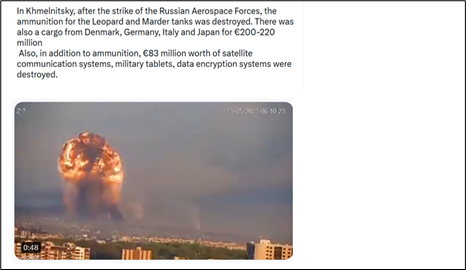
Khmelnitsky ammo depot has turned out to be a gigantic warehouse accumulation of western ammo and all kinds of explosive and other military material from Germany, Denmark, Italy and Japan (e.g. ammo for Leopard and Marder tanks) valued at least $ 220 million, which went up in smoke within few seconds. There were also €83 million of satellite communication systems, military tablets and data encryption systems. Reports tell that a significant number of AD missiles for western-made AD systems, including those for Patriot systems, were stored at this depot.
A large batch of British tank ammunition with depleted uranium, which was recently brought to Ukraine along with Storm Shadow missiles, was also destroyed. As a result of a huge explosion, particles of depleted uranium would be dispersed on the territory of the Khmelnytsky region. Significant increase of background radiation seen in the area, indicating that highly likely a massive amount of depleted uranium ammo for Challenger tanks supplied by the UK were also destroyed.
According to European Seismological Center, 3.4 magnitude shocks were felt in the Khmelnitsky area. This fact indicates the incredible gigantic impact of the explosion, even the seismological activity of the earth was observed.
On May 13, the front-line reports revealed that German Leopard tanks also took part in AFU offensives. In the area of the village of Zaliznyanskoye, one of the Leopards was blown up by an anti-tank mine, previously installed by the fighters of the Wagner PMC. As a result of the explosion, the German tank was damaged and it was immobilized.
May 13, in the evening, Russian cruise missiles were launched in the direction of the Ivano-Frankivsk, Lviv and Ternopil regions of Ukraine. At least six Tu-95 strategic bombers took off from Russian territory in the direction to Ukraine. It is already known that military depots in Ternopil have been hit. An air alert was also declared in Kiev. Explosions are heard in the northern part of the Ukrainian capital.
May 13 was also” black day” for Russian Air forces (RuAF), because AFU troops managed to shoot down, from Chernigov region, Russian aircraft flying in Russian territory and airspace: two Mi-8 helicopters, one Su-34 fighter and possibly one Su-35. Obviously, they were downed by Ukrainian medium-range Buk-AD system and highly likely NATO’s ISR assets were heavily involved in this operation.
May 13, Kyiv used British long-range missiles (Storm Shadow) to target civilian sites in the eastern city of Lugansk, wounding six children. The ministry said Su-24 jet that carried the missiles and a MiG-29 aircraft had been shot down. By announcing it would deliver the air-launched deep-strike weapon, Britain became first country to provide longer-range armament to Kyiv. Russia branded the move an “extremely hostile step.”
May 14
A new devastating explosion took place in Ternopil. Picture below:
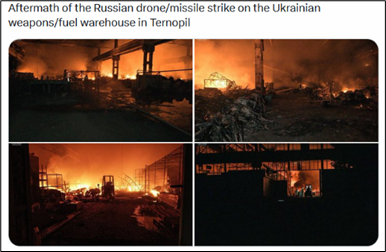
Ukrainian troops tried to break through the Russian defense lines near Artemovsk (Bakhmut) but all the attacks were repelled. In total, the Ukrainian forces lost over 400 military, 12 tanks, 18 infantry fighting vehicles, two armored transports and a D-20 howitzer in this area over the past day. Additionally, Russian troops repelled six Ukrainian attacks near Bogdanovka in the Donetsk People’s Republic and eliminated over 50 soldiers, 7 tanks and 11 infantry fighting vehicles.
May 15
The RMOD said that it had downed a long-range Storm Shadow missile fired by Ukrainian forces. Russian forces repelled a series of massive attacks from the Kyiv regime on the flanks of the town of Bakhmut. Meanwhile, units belonging to the PMC Wagner continue their advance inside the town.
At the same time, panic is developing on Ukrainian social media over reports that during the detonation of an ammunition depot in Khmelnytsky, a large batch of British depleted uranium tank ammunition, which was recently brought in to Ukraine along with Storm Shadow missiles, was also destroyed. As a result of the huge explosion, particles of depleted uranium may have been dispersed on the territory of the entire Khmelnytsky region. Reports claim that the background radiation has increased in the area.
May 16
The RMOD launched a combined attack with long-range precision-guided air- and sea-based weapons against the AFU units, as well as depots of ammunition, weapons and military equipment supplied by Western countries. US-manufactured Patriot surface-to-air missile system has been struck by Kinzhal hypersonic glide vehicle in Kiev. The ministry also said that the Russian air defense systems have intercepted seven Storm Shadow long-range cruise missiles over the past day.
The Kiev regime traditionally claimed that all Russian drones and missiles were intercepted, including several Kinzhal and Kalibr missiles. However, explosions were heard for several hours in Kiev and the head of the local military administration called the attack on the city “exceptional in its density”. Russian strikes caused multiple explosions and fires on the ground. Several explosions thundered in the Solomenskiy district, in the Darnitsky district and near Boryspil. At night, explosions were also reported in the Kharkiv, Kramatorsk and Cherkasy regions.
In the morning of May 16, the RMOD reported: Last night, the Armed Forces of the Russian Federation launched a massive strike with high-precision long-range air and sea-based weapons at the locations of the AFU units, as well as storage sites for ammunition, weapons and military equipment delivered from Western countries. All assigned objects are hit. The hypersonic missile system “Kinzhal” hit the Patriot anti-aircraft missile system manufactured by the US.
The destruction of the US-made Patriot system was filmed by one of the cameras in Kiev. The video clearly shows that the system makes about thirty launches per minute. The Patriot system is the only one deployed with the Ukrainian military capable to launch so many missiles. The deaths of US military advisers who coordinate the operation of the advanced US weapons in Ukraine is also highly likely. The video also confirmed that several Patriot missiles failed to be launched properly and fell on the city streets. During the night strikes, numerous missiles of the Patriot and Iris air defense systems failed and fell in Kiev.
Commenting on the video of the purported Russian direct hit on the Patriot battery, Kim Dotcom wrote on Twitter, seen below.
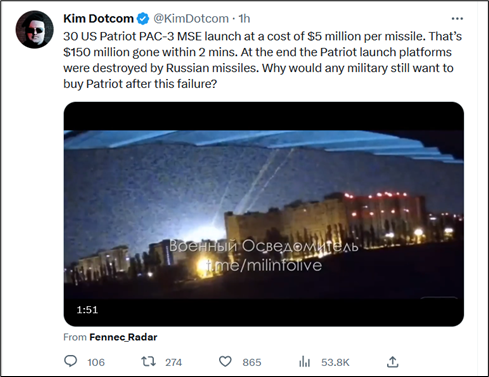
For these reasons, the Pentagon is unlikely to confirm the event, given it consistently backs the narrative advanced by Ukraine’s defense ministry: last Thursday US defense officials announced confirmation of Ukraine’s claims that its military intercepted an inbound Russian hypersonic missile utilizing the Patriot system.
May 17
The final stage of Wagner’s assault in Bakhmut is ongoing. The so-called Domino area is the last Ukrainian stronghold in the war-torn city. The AFU were in control of the last building in the so-called Constructor area. The clashes are also ongoing in the south of the city near the Mig-17 monument. There are only a few houses left until the Wagner PMC takes full control of the city. However, the Ukrainian military is fiercely resisting, fighting for every stronghold. The situation also remains tense on the outskirts of the city. In their turn, Russian forces are heavily shelling Ukrainian forces moving in the area. Most recently, Russian artillery destroyed at least two bridges used for transfer of Ukrainian reinforcements.
Ukraine evacuating radiation victims from Khmelnytsky
In the Ukrainian city of Khmelnytsky, where a Ukrainian army ammunition depot was destroyed by a Russian missile attack, May 13. There was stored tank shells supplied by the UK with depleted uranium cores and now it is reported cases of patients being transported by doctors dressed in special protective suits.
It is also reported about the increase in the level of background radiation in the city. In addition, in the eastern regions of Poland, neighboring Ukraine, in the direction of which the wind blew after the explosion, an increased content of bismuth, which is one of the decay products of depleted uranium, was recorded.
Despite the fact that Ukrainian monitoring resources record a surge in the background gamma radiation in Khmelnytsky and its environs, the Kiev regime denies that radioactive munitions were stored in the destroyed military depot. Meanwhile, pharmacies in the region have run out of iodine, bought up by local residents in an attempt to neutralize the consequences of radiation contamination.
The destruction of depleted uranium munitions supplied by the UK to Ukraine has caused a radioactive cloud that is drifting towards Europe, Security Council Secretary Nikolay Patrushev said. Increased radiation levels had already been detected in Poland. The Western media is silent.
May 18
On the night of May 18, Russian forces launched another massive attack on Ukrainian military facilities across the country. It was largely rated as one of the most massive recent attacks. At night, air alert sounded in all regions of Ukraine. In total, up to 50 cruise missiles of various types and UAVs targeted Ukraine.
The main areas of the strikes were the southern and central regions of the country, where the AFU are accumulating military reserves for their further transfer to the front lines. Throughout the night, Russian missiles, kamikaze UAVs and guided bombs have been targeting the Ukrainian military.
The Russian Armed Forces delivered high-precision strikes with cruise missiles on Ukrainian depots containing foreign equipment and ammunition. As a result, a significant part of Ukraine’s stockpile was destroyed. The movement of reserves into combat areas was also thwarted. The Russian Armed Forces operated in the Kupyansk, Krasny Liman, and Kherson directions, as well as in the Donbass and Zaporozhye regions, in Nikolaev crushing ammo depots and a local HQ of armed corps.
There were two waves of massive strikes. In the late evening, explosions thundered in the areas of concentration of military personnel and equipment in the Kherson, Zaporozhye, Poltava, Vinnytsia, Kirovograd, Ternoopil and Cherkasy regions, as well as in Odessa, Kharkiv and Kramatorsk. In the early morning, Russian Kalibr missiles struck their targets in the Khmelnitsky, Zhytomyr and Kiev regions.
The local authorities confirmed that Russian forces hit their targets in the Odessa region. Damage to a local industrial facility was confirmed, more than ten explosions thundered in the city of Odessa and in the region. One of the first strikes in the region hit Ukrainian military facilities near the village of Krasnoselka located on the north-eastern outskirts of the city of Odessa. A military base used for the training of foreign mercenaries was reportedly located there. Soon, military facilities in different districts of the city of Odessa were destroyed.
Russian strikes destroyed more Ukrainian military facilities along the so-called “Polish” supply line of the AFU, including in the Vinnytsia, Khmelnitsky and Ternopil regions, where Ukrainian forces are transferring foreign military supplies. Russian forces continue to destroy warehouses with ammunition and NATO weapons accumulated for the offensive.
More Russian strikes targeted the Kirovograd region, where at least eight explosions were reported. the capital of the region is the city of Kropivnistky where the headquarters of the 3rd separate Special Purpose Regiment of the Armed Forces of Ukraine, subordinate to the 4th GUR service of the Ministry of Defense of Ukraine, are located.
May 19
Last night, the Russian Armed Forces launched a strike by high-precision long-range sea-based weapons against the AFU’s stations and training centres, as well as depots storing ammunition, weapons and hardware of foreign origin. All the assigned targets have been engaged. The strikes disrupted the supply, training, and formation of reserves of Ukrainian troops to carry out tasks in the areas of combat operations.
Russian forces conducted another series of drone and missile strikes across Ukraine on the night of May 19. Ukrainian military sources reported that Russia launched six Kalibr cruise missiles and 22 Geran-2 drones at Ukraine from the direction of the Black Sea. Dnipropetrovsk Oblast reported explosions near Kryvyi Rih following Russian strikes in the area. The recent uptick in Russian drone and missile strikes, as well as artillery strikes along the entire frontline, are meant to disrupt Ukrainian counteroffensive plans and preparations.
May 20 – Bakhmut fell – Artyomovsk rising
Today AFU defense in Bakhmut has finally collapsed and Russian forces have taken over the whole city. The official name will be turned again in Artyomovsk. The fighting continues in the flanks of the city.
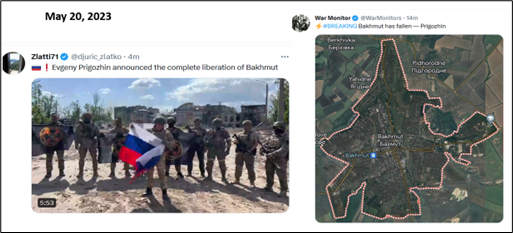

According to some military analysts, within next few weeks, Russian forces will take over also the near-regions around Artyomovsk (inside red line).
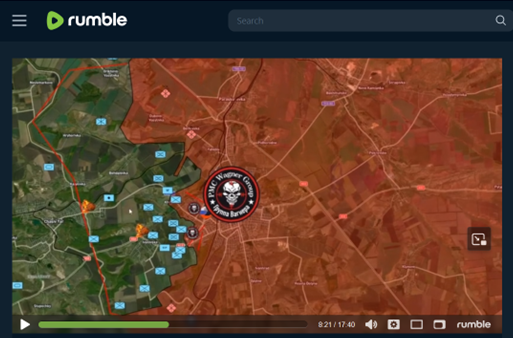
Statements by Josep Borrell
EU foreign policy chief Josep Borrell has made some surprisingly blunt admissions regarding Ukraine’s support from the West in some recent interviews, saying Kiev would collapse in a matter of “days” if military support from allies were to suddenly dry up. First, according to words he gave at an event in Florence via EuroNews:
Ukraine will succumb to the invading Russian forces “in a matter of days” without military support from Western countries, Josep Borrell, the European Union’s foreign policy chief, said on Friday, insisting that the present situation inside the war-torn country is not conducive for launching formal peace talks.
“Unhappily, this is not the moment for diplomatic conversations about peace. It’s the moment of supporting militarily the war,” he also said, explaining further “If you want peace, push Russia to withdraw. Push Russia to stop the war. Don’t tell me to stop supporting Ukraine, because if I stop supporting Ukraine, certainly the war will finish soon.” He admitted, “We cannot just finish because (if we do) Ukraine is unable to defend itself and it has to surrender“.
While speaking to Spanish media on Wednesday, Borrell again emphasized that without the ammo, arms and money flowing from the West – including the US and NATO – Ukraine would lose “immediately”. He added that “I know how to end the war immediately,” Borrell told La Sexta’s El Intermedio show. “Stop providing military aid to Ukraine and Ukraine [will] have to surrender in a few days. That’s it, the war is over”.
Thus, while condemning the Russian invasion, the EU foreign policy chief acknowledged it has become a full-blown proxy war in which one side is entirely propped up by the West.
New “game-changers”
British cruise missile “Storm Shadow”
On May 14, Ukrainian media reported that Ukraine received 200 Storm Shadow cruise missiles from the United Kingdom and is set to receive 400 more in the near future. The British and Ukrainian governments have not confirmed the numbers reported by Ukrainian news sources.
The first reported use of Storm Shadow by Kiev was on May 12, when two missiles hit factories in Luhansk city. The very next day, May 13, at least one Storm Shadow hit the old internal affairs academy building in the city, marking the second attack with the long-range missile. On May 15, the city of Luhansk was again targeted by Ukrainian forces with missiles. According to preliminary reports, the Storm Shadow missiles were used.
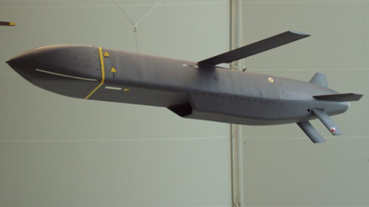
The Storm Shadow is an Anglo-French low-observable, long-range, air-launched cruise missile developed since 1994 by Matra and British Aerospace, and now manufactured by MBDA. The Ukrainian Air Force has reportedly integrated the Storm Shadow on its Soviet-era Su-24 fighter bombers, which have the capability to carry the 1,300 kg cruise missile. It can strike targets up to 300 kilometers away, which is comparable to the US-made ground-launched Army Tactical Missile System (ATACMS). With a price tag of 2 million pounds per a single Storm Shadow, the delivery of 600 missiles to Ukraine would cost the UK up to 1,2 billion.
The Russian Foreign Ministry called the UK’s decision to transfer long-range missiles to Ukraine another “extremely hostile step” that shows the “unprecedented level of involvement” of London in the conflict. The ministry warned that such a step would lead to a serious escalation of the situation in the conflict zone.
American Patriot air defense system, hit by Kinzal
While Kiev regime is claiming every time intercepting all Russian missiles and drones over Kiev, including even hypersonic Kinzhals, the reality seems to be quite different from these fairy tales.
RMOD reported, after May 16 night air strikes, the following: “According to verified information, as a result of a strike by the Kinzhal hypersonic missile system in the city of Kiev a multifunctional radar station, as well as five launchers of the Patriot anti-aircraft missile system manufactured by the United States were hit and completely destroyed on May 16, 2023,” the Russian Defense Ministry said.
On the night of May 16, Russian units hit an American Patriot anti-aircraft missile system during an attack on military facilities in Kyiv. Prior to its destruction, the Patriot fired the entire 32 guided missiles, which cost about $3 million per unit, the value of the salvo was up tom $100 million in two minutes. The cost of the battery itself is from 500 million to 1.5 billion dollars, depending on the complexity of the equipment.
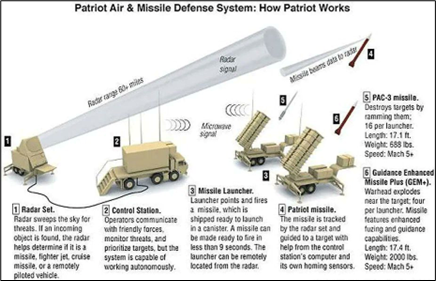
The losses of the strike, May 16, include: the radar and command&control units, five launching units, five soldiers killed, of which two were American instructors. All Western air defense systems are supplied to Ukraine with technical personnel who help our specialists use the anti-aircraft system.
According to unconfirmed reports, the Pentagon has banned Ukraine from using the MIM-104 Patriot air defense system until the American side receives all the information about the circumstances of the recent missile attack on the American air defense battery. Washington sent a special team to Ukraine to assess the state of the affected Patriot air defense system and the reasons for the destruction of the air defense battery by Russian missiles
The NATO has launched urgent meetings because these strikes have just exposed the weaknesses of the US/NATO’s most capable strategic defense systems, which bodes very badly for NATO’s security. It is important to note that Ukraine’s Patriot system was armed with the latest Pac-3 missiles, not the older Pac-2s. This has dire consequences for all European security as it proves that Russian missiles can now penetrate any NATO base in Poland and elsewhere. An urgent meeting was held in NATO on the state of the air defense/PRO systems that protect the main military bases and logistics hubs located on the soil of Poland and Slovakia.
Ukraine received two units of Patriots in mid-April, with the first delivered less than a month before the recent strike. The US repeatedly proved reluctant to provide the assets or to allow its European allies to do so, not only because this would deplete the relatively limited arsenals available to the US Military and its allies, but also because of their extreme cost and the significant reputational damage which their destruction in combat could cause. The system’s failure was widely predicted in light of its highly modest combat record against much simpler missiles than those in Russia’s arsenal. I have analyzed air defense systems before February 5 and March 12, 2021.
The Patriot system targeted was one of two delivered, with Germany and the United States having each supplied a single unit. The unit reportedly fired 32 surface-to-air missiles at the Kinzhal on approach, which at approximately $3 million each amounted to a $96 million barrage to attempt to destroy a missile with an estimated cost of under $2 million.
The very high cost and limited number of the Patriot’s interceptors was a key argument for not sending the systems to Ukraine, with their effectiveness also having been brought to question not only due to the system’s highly troubled combat record, but also to the advanced capabilities of new Russian missiles such as the Kinzhal, Iskander and Zicron. I have analyzed hypersonic weapons October 28, 2021.

Where is General Zalushny?
General Zalushny, Command of Armed Forces of Ukraine has not seen publicly since mid-April. He is reportedly deadly wounded by Russian missile and bombing attack on May 8, in the Dnepropetrovsk region. The top leadership of NATO is not willing to disclose this info.
Below here some tweets about Zalushny:
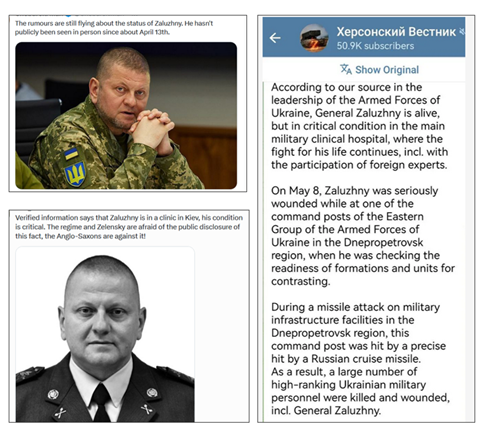
Assessing the possible AFU counteroffensive
The question of today is “Where is the big Ukrainian counteroffensive”?
This much-touted event keeps appearing in the western mainstream media and social media channels since the Fall of 2022, when the commanding general of the Ukrainian armed forces, Valeri Zaluzhny, informed the US and NATO-led Ukraine Contact Group during a meeting in Ramstein, Germany, about the shopping list of military equipment Ukraine would need to carry out a successful offensive operation designed to expel Russian troops from Ukrainian soil.
Jens Stoltenberg, the NATO Secretary General, announced in late April 2023 that NATO had delivered more than 98% of the equipment promised to Ukraine last fall, including more than 1,550 armored vehicles, 230 tanks, and “vast” amounts of ammunition—including, controversially, depleted uranium ammunition used in the British Challenger 2 main battle tanks, and the British-supplied “Storm Shadow” air-launched cruise missile. NATO also provided training for over 30,000 troops, enabling Ukraine to form nine fresh brigades of combat forces capable of delivering punishing blows against the Russian army in Ukraine. Warsaw reported that the West handed over 28 aircraft to Kiev, of which 14 were allocated by Poland, and 575 tanks, including 325 Polish ones.
May 11-15, Ukraine has stepped up efforts along the entire line of engagement but it is not yet a counteroffensive announced and touted by Kiev. The question is more of trying to probe Russian positions by conducting reconnaissance and small-scale scouting combat operations in certain areas. At the same time, the amount of troop losses by AFU has increased at highest level in this year.
However, Zelensky reiterated that this was not enough and the counteroffensive was allegedly postponed. The Ukrainian military is waiting for additional military supplies. The Kiev regime, which has always been using soldiers as cannon fodder to slow down the Russian advance, suddenly worried about the heavy losses during the upcoming offensive operations.
During April – May, Russia has made more and more massive and destructive air strikes, nearly on daily bases, around Ukraine but especially targeting AFU troops concentrations, ammo and fuel depots as well as large warehouses of military equipment and material. All these strikes have depleted AFU’s offensive capability and frustrated execution of attack plans. This is the key fact, why AFU is running out of ammo and equipment and is always begging new supplies.
In early May, the Biden administration appeared to recognize that the announced Ukrainian “counteroffensive” will fail to make much progress. The operation has still not started and Zelensky has moved its launch further into the future: “Zelensky described combat brigades, some of which were trained by NATO countries, as being “ready” but said the army still needed “some things”, including armoured vehicles that were “arriving in batches. So, we need to wait. We still need a bit more time.”
Time will not prevent that any counteroffensive will lead to high casualty rates. In fact, waiting longer means more attacks on the troops in their current positions. Any detected agglomeration of forces or material is already coming under long range Russian missile fire. On the other hand, there are coming more western assessments about the much longer war, a scenario of frozen conflict for years.
NATO chief Jens Stoltenberg has confirmed that NATO deliveries constituted more than 98 percent of the combat vehicles promised to Ukraine. US Secretary of State Antony Blinken broadly endorsed what Stoltenberg said, during a joint press conference with the visiting UK Foreign Secretary James Cleverly. No matter the outcome of the planned Ukrainian offensive, NATO countries “must stay the course and continue to provide Ukraine with what it needs to prevail” in the face of what appears to be a prolonged conflict. Indeed, both Blinken and Cleverly are in sync with what Stoltenberg said. The underlying assumption is that the sanctions will weaken the Russian economy and create social disaffection.
An interesting assessment is available here, in this video where Judge Napolitano interviews American Lt Col Daniel Davis (ret), video link:
Ukraine Offensive: Why It Won’t Beat Putin – Lt Col Daniel Davis (ret)
Weather conditions are no longer an insurmountable factor and Zelensky’s western sponsors want him to get going with the offensive, the sooner the better. Zelensky also has his priorities — first and foremost, his own political survival. He knows that his narrative about an impending Russian defeat, has unraveled and he may become the fall guy in any blame game in the aftermath of a crushing defeat in the crucial weeks or months ahead. He is buying time.
On its part, Russia is doing brilliantly well to keep its cards closed. Russia has the capability to launch a “big arrow” offensive towards the Dnieper but Kremlin’s preference is to continue to grind down the Ukrainian military — a strategy that proved cost-effective in human and material terms, productive and is sustainable.
Depending on the trajectory of the Ukrainian offensive, therefore, Russia has the option to switch to a massive attack to pulverize the adversary. Presently, its heavy bombing campaign is intended to create shock and awe in Kiev and despondency in the European capitals as well as to degrade Ukraine’s mobilization. The West is kept guessing about the Russian intentions.
It looks more and more like the Ukrainian counteroffensive has been postponed to the indefinite future and Zelensky regime is playing a “procrastination battle” for survival.
Epilogue
Regardless of the military outcome on the frontlines, the future of Ukraine will be formulated also on other forums. There are available some interesting videos about the economic and business operations behind the scenes, which will have a great impact on the whole Ukrainian society and nation in the years to come.
A recent Geopolitical Economy Report by Ben Norton “US corporations cash in on Ukraine’s oil and gas”. As Ukraine sells off public assets in a privatization spree, US fossil fuel corporations like ExxonMobil, Chevron and Halliburton are in talks to run its oil and gas industry and the IMF is imposing the Washington Consensus. As the war in Ukraine drags on, the government is selling off state assets in a big privatization spree.
Another interesting video tells that Ukraine’s President Zelensky has met with executives from BlackRock to auction off Ukraine for profit. Video is here “Ukraine is FINISHED and Blackrock is taking over | Redacted with Clayton Morris”.
Reality can sometimes be even more wonderful than fiction.


